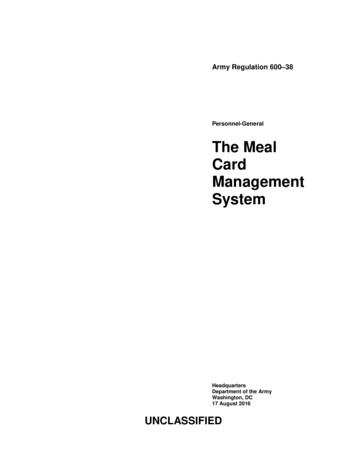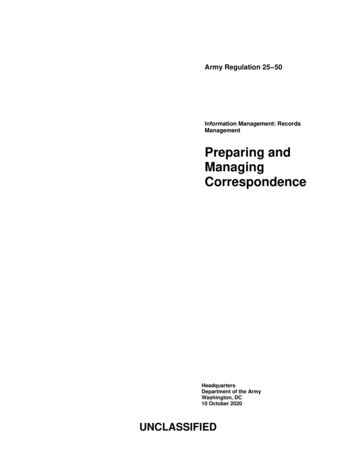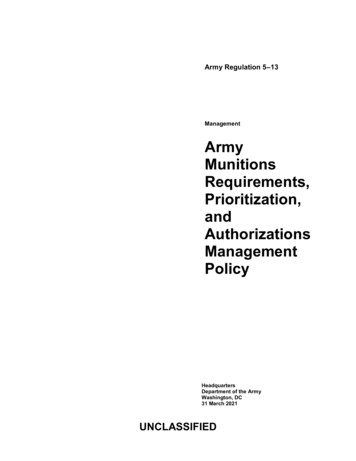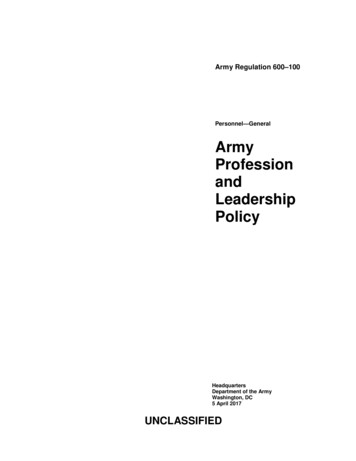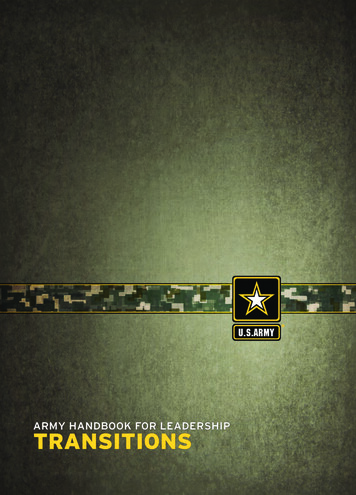
Transcription
The Army Leader Transitions Handbook is designed to helpleaders plan and execute a successful transition to a new leadership position. The intent is to provide a ready referencefor all leaders: direct, organizational and strategic. The ArmyLeader Transitions Handbook offers a methodology to helpleaders transition into a new leadership position as effectivelyand efficiently as possible. The handbook contains best practices and proven techniques from military and civilian sources.The Army Leader Transitions Handbook provides leaders witha step-by-step process for assuming a new leadership role starting from the time the leader is notified of the new leadershipposition to first day actions and considerations for the first90 days and beyond. Although presented as a checklist, theArmy Leader Transitions Handbook should be viewed moreas a menu of ideas for the leader to choose. Preparation is thekey to a successful leader transition.
1. PREPARATIONUnderstand OrganizationInternal/External StakeholdersOutgoing p Transition PlanConduct Self AssessmentProduce Initial DocumentsPlan of first 90 daysPhilosophy, In-Brief, Performance ObjectivesComplete Army Transition RequirementsPCCsCDR/1SG CoursesProperty InventoriesPrepare for CeremoniesComplete Installaion In-Processing2. FIRST DAYExecute ceremoniesEstablish First Day PrioritiesWho to meet; What order; WhereRecall Rosters UpdatesPropert Transition3. INITIAL ASSESSMENTCompetence/SkillsExpedite LearningEstablish LD PlanEnvironmentBe VisibleInternal — interviews, surveys,Determine Preliminary Findings & Initialmeetings, in-briefsExternal — higher, HQ, InstallationAssessmentAssessment ProblemsPersonnel, etc.Quick WinsSubordinatesValidate Findings & AssessmentStudy, Observe, QuestionChallenge feedback and observationsListen AccessBuild CredibilityLEADER TRANSITION MODEL
4. ALIGNMENT AND TEAM BUILDINGReview & Develop OrganizationalAlignmentVision (or Focus)MissionGoalsObjectivesEstablish Key MilestonesSecure Quick WinsConfidence, trust, credibilityMomentumAvoid pitfalls: dogmatism,forgetting endstateConsider Organizational RedesignNecessityAlignment ation of work effortBuild the TeamPeople with authority, resources, freedom, systems,and culture to complete tasksEstablish Sense of UrgencyCreativity and insights brought forth by anxiety andchange5. ESTABLISHING ROUTINESEstablish Routine MeetingsProgress, resource allocation,feedbackInitiate STRATCOM PlanVision, Mission, Goals, OBJs,MilestonesQuick-WinsCulture/build unityBuild CoalitionsInternally and externallyCapitalize on othersEliminate Needless Constraints6. TRANSITION OVERFacilitate the Next Transition7. SUSTAININGManage Systems & Operations
USING THIS HANDBOOKThis handbook is intended for all leaders. Although this handbookdescribes the leadership transition process and timeline in a linear,sequential fashion, you can tailor this process and timeline to meetyour specific transition needs. Some leaders may be going throughtheir first transition, with very little time, and little guidance. Othersmay be thoroughly experienced at transitions yet have not capturedthese experiences properly and are looking for a comprehensive aid.Leaders at both ends of the spectrum and in between can use this guideto help shape their transition strategy. Based upon your own assessedrequirements, use this guide as a tool to meet your transition needs, oruse specific phases or segments to fill known gaps.A leadership transition occurs every time a leader assumes a new position and must lead others with new and/or broader responsibilities.For most Army leaders transitions occur into new units or organizations. The leader will be the new face among a mix of existing andnew personnel. It is imperative that transitions occur efficiently andeffectively particularly during this era of persistent conflict and highoperations tempo. Leadership transitions can occur for many different reasons (selection, promotion, lateral move, permanent change ofstation move, etc), in every type of organization (operating force, generating force), at every level of leadership (direct, organizational, andstrategic) and across all cohorts (officer, enlisted, and Army civilians).The challenges of leadership are often greatest when there is a leadership transition and thus a shift in roles and responsibilities. The Armyreassigns leaders with regularity; yet has not formalized this significantevent in its leader development process.2 — USING THIS HANDBOOK
CONTENTSPHASE I: PREPARATION (Notification to D-1)Step 1: Gain Understanding of the OrganizationStep 2: Develop a Transition PlanStep 3: Conduct a Self-AssessmentStep 4: Produce Initial Leader Transition DocumentsStep 5: Complete Mandatory Leader Transition Events/RequirementsStep 6: Prepare for Change of Command/Change of Responsibility ceremonyStep 7: Complete Installation In-Processing RequirementsPHASE II: FIRST DAY (D Day)Step 1: Execute Change of Command / Responsibility ceremony (as required)Step 2: Establish First Day PrioritiesPHASE III: INITIAL ASSESSMENT (D 1 to D 30)Step 1: Expedite Learning to Assess the Organization and Your SubordinatesStep 2: Build Credibility as the New LeaderStep 3: Determine Preliminary Findings and Initial AssessmentStep 4: Validate Preliminary Findings and Initial AssessmentPHASE IV: ORGANIZATIONAL ALIGNMENT & TEAM BUILDING(D 31 to D 60)Step 1: Review and Develop Organizational Alignment – Vision, Mission, Goals,ObjectivesStep 2: Establish Key MilestonesStep 3: Secure Quick Wins and Short-term Victories Identified EarlierStep 4: Consider Organizational RedesignStep 5: Build the TeamStep 6: Establish a Sense of UrgencyPHASE V: ESTABLISHING ROUTINES (D 61 to D 90)Step 1: Establish Routine MeetingsStep 2: Initiate Organizational Communication (STRATCOM) PlanStep 3: Build and Sustain Knowledge Management SystemsStep 4: Build Coalitions Internally and ExternallyStep 5: Eliminate Needless ConstraintsPHASE VI: SUSTAINING (D 91 )Step 1: Manage Organizational Systems and OperationsStep 2: Facilitate the Next Transition
PHASE ONE PREPARATIONNotification to Day OneLeadership transitions often have no stated goals or outcomes. The new leader probably will not be given a plan. Most organizations will provide the incoming leader witha planned set of activities during the transition period. The organization may have anagenda, i.e., to showcase itself and to avoid change. The period between your notification of a new leadership position and the day you assume responsibility provides thepotential to contribute significantly to the organization’s success. After assuming a newleadership role, time will become your most constrained resource, so taking advantageof this time is critical. Assessing and gaining an understanding of the organization, theenvironment within which it operates, the internal and external factors affecting theorganization and conducting a self-assessment (which many overlook) are importantaspects during Preparation. These critical actions can help you gain the initiative andbuild momentum during the first few months that can be vital to improving the organization. The following are some effective methods and a compilation of techniquesand considerations which have been used successfully by other leaders before theyassumed responsibilities.Step 1: Gain an Understanding of the OrganizationLeader AdviceManaging transitions is aleadership responsibility.Leader transitions withinthe Army are significantevents for any organizationdue to their complexity andimpacts upon the organization as a whole.Before you arrive or start at your new unit,gather information that will be useful indeveloping a sense of the organization’s mission and how it achieves it. Organizationalcharts, briefings, mission statements and histories provide background information onthe formal aspects of the organization. Networking with colleagues and acquaintancesabout what they know about the organizationis a way to gain insight into the organization.The main goal during this step is to gather asmuch valid, relevant information to help youassess the state of the organization and howyou may want to reshape it.To assist in later decision making, leaders should categorize relevant information intogroups to facilitate understanding of the organization’s context. One possibility is togroup the information into training, maintaining, leading/developing, caring andreadiness categories.4 — PHASE ONE PREPARATION
Make InitialContactIntroduce yourself and ask for ideas on what you should do toprepare for your new position. Keep in mind that the outgoingleader is still in charge of the organization, so respect that relationship/position. Learn as much as possible without interferingin current affairs. Establishing a good dialogue with the currentleader is essential for a seamless transition.RequestOrganizationalDocumentsFollowing the initial contact, ask the current leader or designatedcontact to send copies of items needed to gain an understanding of the unit’s capabilities, requirements and results, i.e. unit’sMTOE/TDA; long range training plan; tactical, maintenanceand garrison SOPs; current policy letters; etc. This will help youunderstand how the organization ine what the unit is capable of performing by referring toorganizational documents such as: MTOE, TDA, property books,core function regulations, manpower surveys, etc.IdentifyOrganizationalRequirementsDetermine the unit’s current requirements by referring toorganizational and higher HQ documents such as: mission,METL, annual and quarterly training guidance, higher HQIntent, long/mid/short-range training schedules; tactical,garrison, maintenance SOPs; rating schemes. Review applicable branch or proponent specific field manuals and Armyregulations and system-oriented technical manuals.ReviewOrganizationalResultsConduct a review of results oriented organizational documentsto gain an understanding of where they currently stand: UnitARTEPS/EXEVAL results, quarterly training briefs, USR-TSR(TRADOC only), MRE-CTC AARs, inspection reports; climatesurveys, etc.CoordinateDiscussionsPointsAs time permits, discuss the following: Current mission and organization, thoughts on upcoming training and education requirements, operational events and OPTEMPO, goals and prioritiesalready established for the unit, the higher leader’s intent, guidance and long range plan, the current and projected key personnel situation, experience level of subordinates, the organization’sstrengths and weaknesses, two or three events that impacted theorganization and the results, the overall organizational climateand reputation, disciplinary situations and investigations currently in progress, and finally, ask what should be changed if heor she had it all to do over again.
OutgoingLeader’sAssessmentAn important item to obtain from the current leader is a list ofkey contacts and current ‘hot issues’. A bookshelf of bindersabout previous event history is usually not as helpful as a thinbinder of concise information on the organization from the outgoing leader’s perspective and explanation of the issues (why itwas hot and why these had not already been resolved.) This thinbinder should be prepared in a format that answers ‘questions Iwish I had asked when I took over as leader’. Incoming leadersshould be wary of unwittingly adopting outgoing leaders’ preconceptions about abilities, previous performance and/or pastmistakes of subordinates.UnderstandOrganizationalCultureReview organizational documents to make an initial assessmentof the organization’s culture, such as: Review higher HQ philosophy letters, read command policy letters (from organization and higher HQ): helps define the current organizationalenvironment and culture, what’s currently important, conduct alegal review of organization to identify disciplinary trends (ART15s, AR15-6 Investigations; etc), and read the organization’s andhigher HQ CCIR/SIR – these are the non-negotiables.Identify & Meet with Organizational Key StakeholdersAs part of your awareness of environmental conditions, you should identify key stakeholders and learn what they value about the organization that you will be leading. Astakeholder is anyone who affects or can be affected by an organization’s actions. Thelist below describes information you can obtain from internal and external stakeholders to improve your understanding of the environment.INTERNAL KEY STAKEHOLDERSSuperiorsEstablish early relations with your future immediate boss. Consider this the most important stakeholder relationship because itcan: Open access to available resources, ensure expectations areset up front, establish a means to provide regular status reports,and provide the opportunity to present and coordinate yourleader transition timeline.Chain ofCommandDiscuss expectations, goals and receive initial guidance fromyour Rater, Intermediate Rater and Senior Rater.6 — PHASE ONE PREPARATION
PeersDiscuss different ideas and programs. Don’t be reluctant to adoptothers’ good ideas.Staff (ifapplicable) andHigher HQ StaffMeet initially to discuss systems, processes, SOPs within the organization (how we do business here).SubordinatesMeet with everyone you will rate or counsel. Initially just meet tointroduce yourself. Formal counseling should not occur until later.Other SpecialInterest InternalStakeholdersContact other special stake-holders, e.g. Family ReadinessGroup (FRG).EXTERNAL KEY STAKEHOLDERSInstallation orGarrisonYou may meet with these stakeholders after you assume the newleadership position (see Phase III, step 1), but early contact mayprepare you for your new position and help you better anticipateproblems. Meet with personnel external to the organization whofocus on the organization’s well-being (e.g., Installation / higherHQ Chaplain, SJA, Inspector General, Installation EO, SafetyOffice, DSCRM [budgeting], WTU commander, hospital commander, clinic OICs, ASAP personnel, AG, DOL, DPTM, CPAC/CPOC, etc) early on.Branch andTechnicalPOCsContact branch or technical points of contact. Examples includethe Logistics Assistance Representative (LAR) and School Centers of Excellence.SupportedUnits (ifapplicable)Visit the organization(s) you support – show that you care howwell your unit supports others. Visit frequently and speak withtheir subordinates to get their impressions of your organization.Branch andTechnicalPOCsVisit the organization(s) you support – show that you care howwell your unit supports others. Visit frequently and speak withtheir subordinates to get their impressions of your organization.OtherOrganizationalSMEsContact other experts in similar organizations.
Determine how often you should interact with your stakeholders over the course ofyour transition and tenure (once, weekly, monthly, etc) and in what venue (meeting,email, etc). Additionally, aside from your immediate boss, determine who the prioritystakeholders are. For all stakeholders determine their interests, the impact they haveon your organization, and the purpose of each meeting.Step 2: Develop a Transition PlanDevelopa FormalTransitionPlanIn coordination with the departing leader, develop a formal transition plan. The plan should be focused on the organization - notnecessarily on you as the new leader. Focus on people and nestthe transition schedule within the existing organization’s battlerhythm.Handoverof Other Jobs& FunctionsMilitary leaders usually transition during high permanent changeof station (PCS) cycles. Ensure a smooth handover of other jobs/functions from the position you are leaving to assist your successor and preclude issues that require your follow-up.KeyInformationFlowAsk the outgoing leader to share information with you inadvance to increase your situational awareness. This is especiallycritical if the unit is deploying soon after the leader transitionoccurs. This also allows you (and your family) some predictability regarding upcoming requirements.OfficeHandoverPlanSynchronize schedules for vacating and occupying the office. Tryto ensure that the outgoing leader leaves you with the organizational equipment necessary to do your job. Having automationitems, phones, pens, pencils, in/out boxes in place prepares youto lead your organization from day one.8 — PHASE ONE PREPARATION
Step 3: Conduct a Self-AssessmentUnderstanding yourself is a powerful skill for every leader. If you understand yourstrengths, weaknesses, and tendencies under various conditions you will have a betterunderstanding of yourself. If you know yourself, you can know better how to interactwith others and how they are likely to interact with you. Various tools are available tohelp you gain that understanding:ArmyMulti-SouceAssessmentand FeedbackThis program centers on 360o assessments obtained from multiple sources with feedback given based on the different perspectives. Assessments and comments are collected from the assessedleader (self), superiors, peers and subordinates. Assessments areobtained on leader competencies and attributes – the essentialingredients of an Army leader (see Appendix A, FM 6-22). Afeedback report is generated comparing results across the different sources. Results are provided to the assessed leader and areanonymous and confidential. Coaches are often used to facilitateinterpretation of the feedback. After internalization of the resultsthe leader develops a plan to act on the feedback. (Link availableat http://msaf.army.mil).Center for ArmyLeadership’s(CAL) SelfDevelopmentHandbookThis handbook offers exercises and information you can use todetermine your self-development direction and start immediatelyworking toward it. If you already have a direction for your selfdevelopment, the handbook will also help you achieve progressin that direction. (Link available at hipTransitionsCustomizedCoursewareThe courseware consists of several key elements essential to successful transitions: Prepare for Transition, Develop Goals, Optimize Learning, Develop Strategy, Manage Change, Shape theTransition Environment, Build Teams, and Focus/Align TeamEffort. The courseware allows users to tailor training materials to specific needs. Users access this at the CAL AKO websiteor Army eLearning rmylogin.cfm. New users must register with eLearning.Then login, select “Army Custom Curricula” and scroll to “Center for Army Leadership - Leadership Transitions”. This containsa subfolder for each topic. These subfolders contain numerouscourses, tools, job aids, and simulations to help a leader transition into a new leadership position.
SELF READINESS FACTORSPHYSICALAssess your physical fitness and train accordingly.Physical training may be one of the first events theSoldiers and civilians will see you do; it is a chance toset an initial good impression.TECHNICAL ANDTACTICAL COMPETENCYReview your individual Soldier skills.Soldiers and civilians will evaluate youon your competence. Don’t ask them todo something you cannot do in this area.Read professional, applicablepublications. Maintain technicalproficiency; stay current.ADMINISTRATIVESKILLSLeader AdviceTake your time; organizeyour thoughts and comments. Everything yousay will be critiqued bysomeone.10 — PHASE ONE PREPARATIONBrush up on personnelmanagement, especially leaderdevelopment. Know UCMJ,promotions, administrativedischarge procedures, drug andalcohol programs, family advocacyprocedures and officer, enlisted andcivilian rating procedures.Be computer proficient when youarrive. Most Army communication iscompleted via automated systems.Ensure that all uniforms areserviceable. Learn the organization’sunit history. Get your personal life inorder. Take care of any family, healthor physical problems prior toassuming the leadership position.
Step 4: Produce Initial Leader Transition DocumentsAfter developing your situational awareness, reflect on what is important to you froma leadership standpoint. Document your leadership philosophy and assignment goals.The leader should prepare these supporting transition documents.LeadershipStatementEven if not at command level, you will need a statement abouthow you are going to lead your organization. Quality leadershipphilosophies include the following characteristics: It is appropriate, as a new leader, to write your leadership statement. Documenting provides your subordinates a reference theycan use for clarification of your intent and style. Your statement sets the tone for the organization. Keep it short(preferably not to exceed one page in length), but make sure itsays what you mean. You will be judged by what is important toyou and your ability to live up to it. This is your initial chance to make sure your organization knowswhat you expect. You should publish it soon after you take over. Keep it to one page but use bullets, not paragraphs. This willallow you to easily brief your entire organization (like in a theater) and since your unit (the people in it) will change often dueto PCS or task organization it will save you (or your staff) time byjust doing it once. Thoughtfully prepare and rehearse what you will say the firsttime you talk to your personnel. Be prepared to cover your statement of what you expect of yourself as their leader and thosethings you consider non-negotiable.Vision orFocusVision is a brigade-level and higher term. Focus is a battalionlevel and below term. Both are a conceptual image of the desiredfuture for the organization. The statement should be short andconcise with every word meaning something. Take every opportunity in your organization to use them and promote the ideasbehind them. Add the ideas to the core competency for your unitor organization. Obtain feedback on them from your subordinates prior to publishing.CalendarItemsSynchronize your transition events and activities for your first 90days with the organization’s current battle rhythm (daily, weeklyand monthly) and current calendar of events (short, mid andlong range).
Major DutiesResponsibilitiesand PerformanceObjectivesProvide your list of major duties, responsibilities and performance objectives from your support form to all subordinatesprior to their initial counseling.OrganizationalInbriefBe prepared to brief everyone about yourself and address thosethings that you value. Inform every one of your expectations ofthem and the organization. Consider addressing the followingtopics: values, ethics, objectives, integrity, priorities, disciplinestandards, training and education, safety, maintenance, leadership, Soldier and family care. Use this as the basis for a recurring‘Newcomers brief’.Leader ofIntroduction toFamily MembersWrite a letter of introduction to family members and align it withthe Army Family Covenant. This shows your commitment to Soldiers, civilians and their families.BusinessCardsPrepare business cards in advance of your first day. These areuseful when coordinating with stakeholders. They are one smallindication that you truly want to maintain contact.CCIRSIRCommander’s Critical Information Requirements (CCIR) andSerious Incident Report (SIR) are standing requests for what youalways want to be informed about. These are so important thatyou expect to be interrupted or awakened to be notified. Youshould refer to the higher HQ CCIR / SIR in the development ofyour priority standing information or incident requirements.InitialCounselingFormsPrepare initial counseling forms for all subordinates you will rate.PersonalBiographyDevelop or update your personal biography. Depending on yourlevel of leadership, it may be needed for various publications orscheduled appearances.Assumptionof CommandMemoDraft an assumption of command memorandum as appropriateper AR 600-20.12 — PHASE ONE PREPARATION
Initial PolicyLettersPrepare initial policy letters. These can be based upon previousleaders’ policies, higher HQ mandates, what you think is important, etc. Before you publish them have the Inspector General(IG) and Staff Judge Advocate review to ensure enforceabilityand legality.Leader AdviceBalance continuity withthe necessity of change.Step 5: Complete Mandatory LeaderTransition EventsBN/BDE LevelPre-CommandCSM Courses(If applicable)Identify opportunities and schedules for required courses.Typical leader transition event courses include Pre-CommandCourse/Command Sergeants Major Course (PCC) and TacticalCommander’s Development Program (TCDP); and branch, technical and specialty PCCs. These courses are conducted at Fort Leavenworth and atbranch schools. They provide refresher training to assist you inpreparation for command. Encourage your spouse to participate in the Leavenworth PCC.It is an excellent opportunity for the two of you to discuss expectations and agree on respective and shared roles in unit activities.CompanyCDR and 1SGCoursesCompany Commander and First Sergeant Courses are post-specific and differ somewhat in intent across locations. All are oriented to company level leadership responsibilities.Change ofLeadershipPropertyInventoryRequirementsRefer to inventory procedures described in AR 710-2, AR735-5, DA PAM 25-30, DA PAM 710-2-1 and Command Supply Discipline Program (CSDP). Be careful that accountingfor property does not take precedence over focusing on theorganization’s people.
Various OtherRegulatoryRequirementsMandatory events within 90 days for company level include aCommand Climate Survey (AR 600-20) and command inspections (AR 1-201). Identify other requirements that apply to yourspecific organization, level of leadership and the type of position.Relief-In-Place(RIP) andTransition ofAuthority (TOA)Some transitions will involve relief-in-place and transition ofauthority. These are only executed in an operational (deployed)environment (FM 3-90).Step 6: Prepare for Change of Command/Change of ResponsibilityCeremony (as required)InvitationsOutgoing and Incoming LeadersYourSpeechRehearse your comments. When you address the organization,keep your remarks brief. Remember the day belongs to the outgoing leader. Know who is in the audience and recognize VIPsin your remarks.RehearsalTime andLocationThe time and place of the event is scheduled by the staff. Coordinate with the staff.CeremonialNarrativeand ScriptThe sequence of events is developed by the staff. Make anyrequests of them, but remember they work for the outgoingleader.Program withBiographiesCheck the program and provide biographical information toinclude past duty assignments, awards, and family informationReceptionSelect location and caterer. Schedule your reception for nearby,but separate from the change of command / responsibility site.All ResourceRequirementsCheck that details have been planned and prepared for (publicaddress system, color guard, etc).14 — PHASE ONE PREPARATION
Step 7: Complete Installation In-Processing Requirements (If applicable)Complete your own in-processing to ensure you are later free from distractions. Thisalso allows you to gain a first-hand appreciation of how your Soldiers and civilians aretreated. Try to get your family settled at home prior to assuming the leadership role.Familiarize yourself with the installation, training areas, post facilities and the servicesavailable for your Soldiers, civilians and their families.Leader AdviceThe situation dictates the approach one takes during the first 90days. New leaders should conduct an assessment prior to takingover and continue for the first two to three weeks. Be careful ofjumping to conclusions. There is nothing more disruptive thanhaving a new leader who comes in and dictates personal priorities, objectives and intent on the first day, as they may be way offthe mark from what the organization really needs in terms ofpurpose, direction and motivation.
PHASE TWO FIRST DAYDay One (D Day)The first day is an important one in your new organization. What you do – and whoyou spend time with on the first day - will signal to Soldiers and civilians what and whois important to you. For commanders this should be your ‘top NCO’ as this transmitsthe value you place on your enlisted leadership. How you operate will be a preview ofthe changes ahead for the organization. If you delegate the scheduling of your day orgo along with previously scheduled appointments, you are sending a sign that you donot care to manage your own time and that you are satisfied with being reactive to thedemands requested of you. Two important steps should be part of your first day.Step 1: Execute Change of Command/Responsibility Ceremony (as required)Participate in a change of command or responsibility ceremony as appropriate.Leader AdviceThe new leader should seeall personnel in the first48-96 hours – for an introduction and discuss philosophy a bit. This is differentthan setting a course for thefirst 90 days; it is part of theassessment. The new leadercan determine a lot aboutan organization, and so canthe Soldiers and civiliansregarding their new leader,just by how the meeting isarranged, organized andexecuted.Step 2: Establish First Day PrioritiesThe incoming leader should develop andcontrol these priorities – not subordinatesor staff. Do not schedule too much for thefirst day. A good rule of thumb is to minimizedisruptions at the Soldier level.Who you meet with firstsends an unspoken message to everyone in theorganization. Consider meeting only initially(day one) with a select few. For example, atthe command level, consider meeting withthe CSM, XO, S3, subordinate commanders and staff. Open communications early.Leave plenty of time for visits to see Soldiersat their duty stations or in training. Establishthe relationship with your organizationalpeer (enlisted/officer/civilian) early and showcase its importanc
The Army Leader Transitions Handbook is designed to help leaders plan and execute a successful transition to a new lead-ership position. The intent is to provide a ready reference for all leaders: direct, organizational and strategic. The Army Leader T



